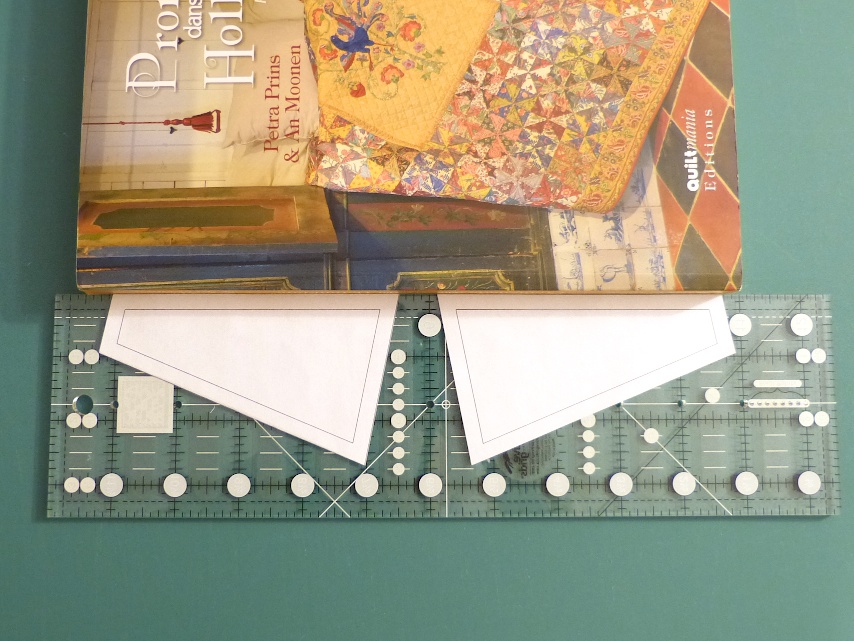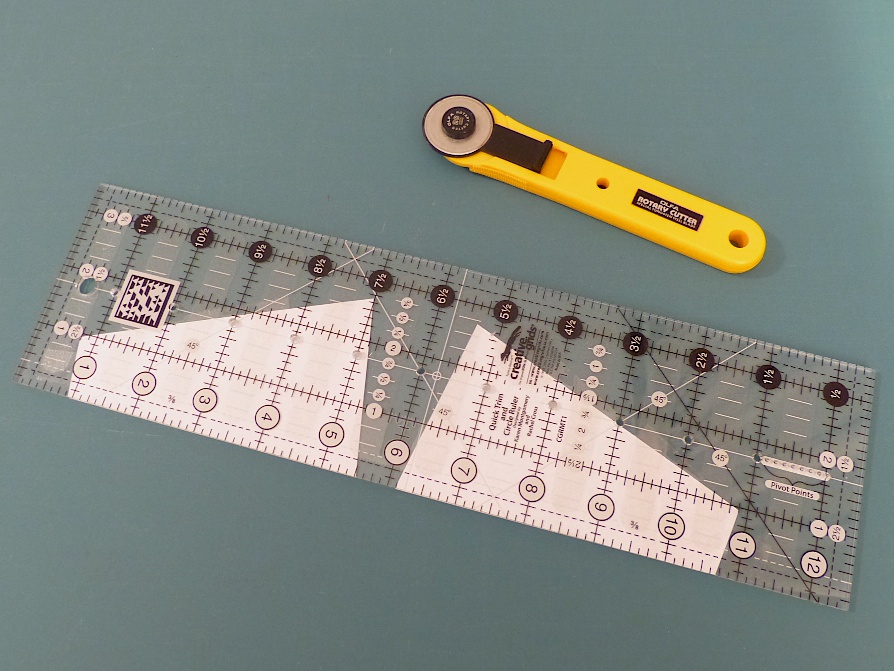How Big Is 30 Degree Dresden Plate Template
Tutorial – Dresden Plates without a Specialty Ruler
Well, I do have a specialty ruler by EZ Quilting for cutting Dresden blades. But it is a 18 degree ruler and then in lodge to brand a full circle I have to cutting 20 blades and sew together 20 side seams, xx peak seams and press 20 side seams and 20 pinnacle seams. That's tedious piece of work. And then in order to be less onerous I decided to reduce the number of blades and nevertheless brand it await like a Dresden plate cake. Mathematically it also needs to exist hands divisible past 360 (to form a circle) and iv (to be divisible in to halves and quarters and then it can exist easily centred to the background fabric and can be easily converted to a border design or fan patterns). The magic number happens to be 16. Since 16/20 = 0.viii, information technology will take me 20% less time to assemble a block. As well, 360/16 = 22.5, information technology can be easily drafted, particularly when I have admission to AutoCAD.
So, are you interested in Dresden forth? Feel complimentary to download and print the free Dresden templates (also supplied in the Patterns page) for this tutorial. The starting time page contains a prepare of ii identical cutting templates for rotary cutting fabric blades, and the second folio contains a pressing template for making a cardboard blade to press the pieced fabric blades centered. The finished Dresden Plate has a 10.5" diameter.
This tutorial not simply gives instructions on using the paper templates but also full general guidelines on assembling a well-executed Dresden cake. For all the efforts involved, it is worthwhile to exercise the job the right and accurate style. Without much more wistfulness, let's get started!


one. Print and cut the cut templates. Please print with letter size paper and Do NOT Scale the printing. Align and attach the templates to one long border of a rotary cutting ruler with invisible tape. Lightly pushing the ruler and templates against a book before taping helps to align the templates precisely.
two. Prepare four.five" wide fabric strips. Experience free to mix and friction match all sorts of prints and utilize the bit pieces. Stack three to iv strips together for speedy rotary cutting. In this tutorial I stacked iii strips together.
three. Position the ruler equally shown, cutting the offset ready of blades with the upper template. After the first cut, take the blade gear up out (just do not separate or misconstrue the pieces), turn them up side down and cut the other side with the lower template. Past at present you may have realized why nosotros need two templates: I for cutting the left edge and the other for the right edge!
four. For the subsequent cuts, simply move the ruler up and down, alternate between the upper and lower templates and cut every bit many blades as you need. Reminder: sixteen blades = 1 Dresden plate.
Cute, eh? Now, the cutting part is washed. Let's proceed to the sewing part.
v. Fold each blade in half lengthwise, right sides together. With run up length gear up at virtually 1.v-2 mm, sew across the top edge. Chain-piece all blades. When finish sewing, trim the corner at the fold, turn bract right side out and finger-printing seam allowance open, A stiletto or fabric turner helps to brand the peak pointy.
6. Now, print the pressing template (it does not contain the quarter inch seam allowance on the pinnacle border) and utilize it to make a pressing cake with medium to heavy weight cardboard (recollect of cereal boxes). Marker the middle line on the cardboard cake. Before you printing a blade, insert the paper-thin block into the blade, align the seam with the marked middle line. Press seam allowances open up (yous need to finger-press first so that the seam allowances would be less wayward under the iron).
vii. Dorsum to the sewing machine. Piece 16 pressed blades together to grade a "Dresden donut". Press seam allowances open (again I prefer all seam allowances opened to reduce bulkiness).
8. Cutting 4.25" (roughly) diameter circles in fabric of your option. Make a 3.5" diameter circular cardboard template (or other sizes/shapes your prefer). Prepare the centre piece as shown. Alternatively, you can utilize fusible appliqué methods to set up the centre slice.
9. Pin the centre slice on top of the donut, car or hand sew them together. I car stitched with a blanket run up pattern.
10. Finally, gear up a 12.5" x 12.five" background square, center the Dresden plate on elevation. The nearly efficient way to center the cake is to but draw an "Ten", corner to corner, on the groundwork square. Finally, I did direct edge stitching along the periphery of the Dresden plate to sew them together.
I must admit information technology'due south a lengthy process but lots of fun! Feel complimentary to jump dorsum and forth inside the assembly line and make the work less tedious! I am certain you will be 100% pleased with the last results!
How Big Is 30 Degree Dresden Plate Template,
Source: http://www.cottonconfections.com/blog/2014/3/21/tutorial-dresden-plates-without-a-specialty-ruler
Posted by: eldredwoud1941.blogspot.com


0 Response to "How Big Is 30 Degree Dresden Plate Template"
Post a Comment